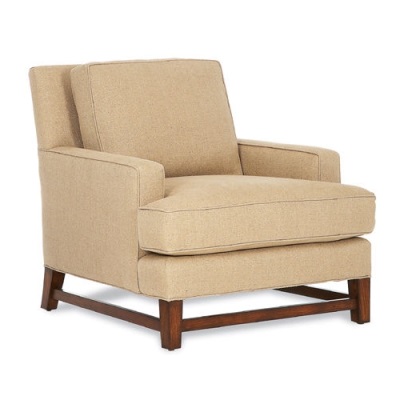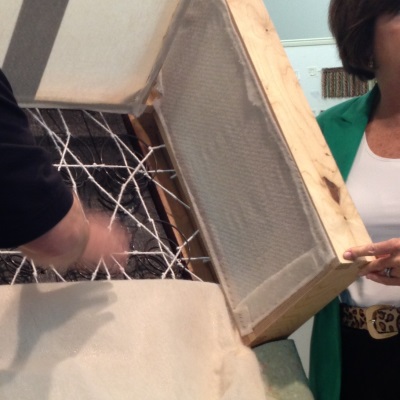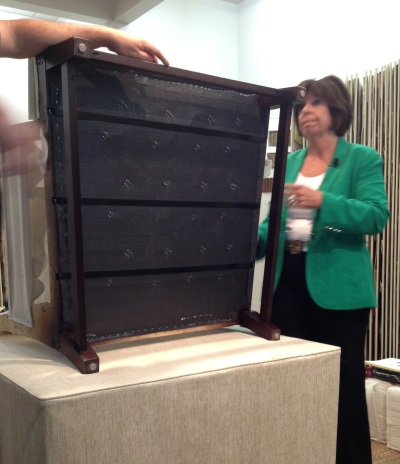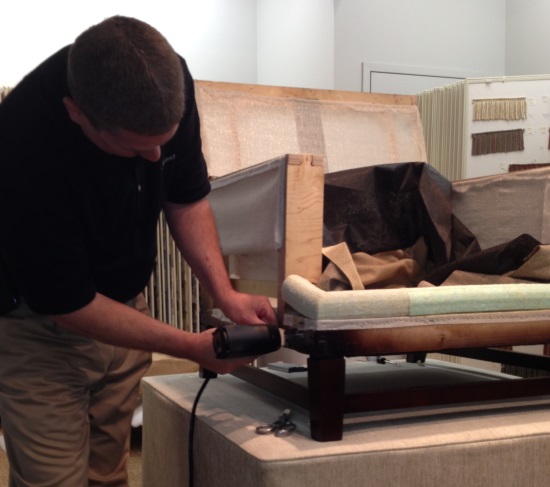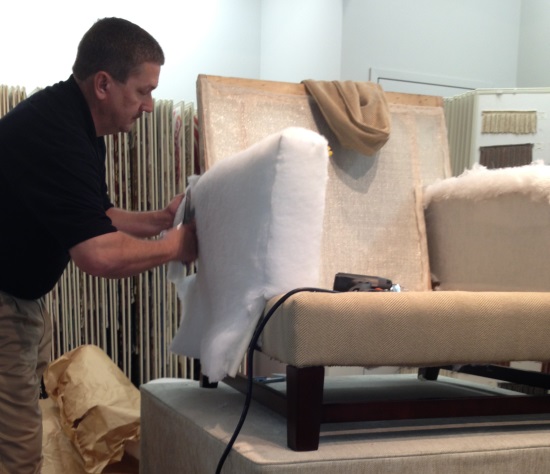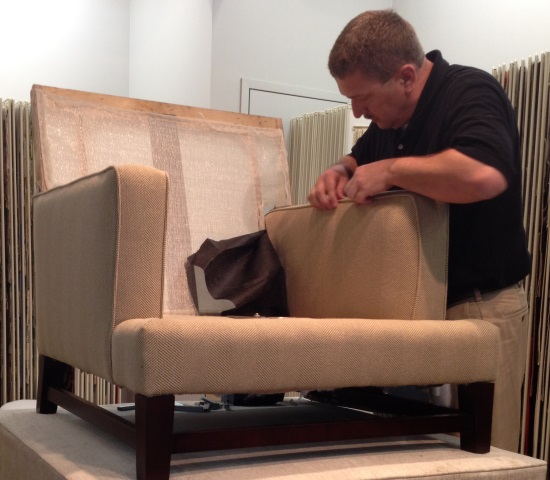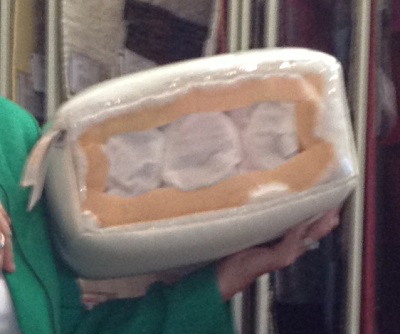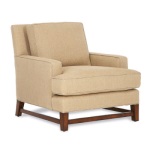 Yesterday I had the opportunity to see a chair-making demonstration by one of Kravet Furniture’s master upholsterers. If you’ve ever wondered what secrets lie beneath the cushions of your favorite chair or sofa, here’s your chance to take a peek “behind the seams” and see how a really high quality piece is constructed. My clients sometimes ask me if it’s worth it to re-upholster a favorite piece vs. buying new. Generally it’s all about the quality of the frame and construction of the chair itself – factors that are not always visible from the outside. In this post I’ll share what I learned about the markers of quality upholstery from Kravet. Oh, and at the end of the demonstration, one lucky attendee was selected by drawing to win the chair! I’ll get back to that in a minute.
Yesterday I had the opportunity to see a chair-making demonstration by one of Kravet Furniture’s master upholsterers. If you’ve ever wondered what secrets lie beneath the cushions of your favorite chair or sofa, here’s your chance to take a peek “behind the seams” and see how a really high quality piece is constructed. My clients sometimes ask me if it’s worth it to re-upholster a favorite piece vs. buying new. Generally it’s all about the quality of the frame and construction of the chair itself – factors that are not always visible from the outside. In this post I’ll share what I learned about the markers of quality upholstery from Kravet. Oh, and at the end of the demonstration, one lucky attendee was selected by drawing to win the chair! I’ll get back to that in a minute.
Kravet Inc. is a family owned and operated furniture company that produces high quality upholstery, casegoods and textiles. Many of their products are made just down the road in Hickory, NC. At yesterday’s demonstration, master upholsterer (and 3rd generation upholsterer!) Steve Bolick wowed us with his technical skills and artistry as he built this chair in about three hours. Kravet’s VP of Sales Susan Lorenz explained the process and details behind the craftsmanship as Steve worked.
So what IS the difference between a $300 upholstered chair from Chairs ‘R’ Us and one that costs five to ten times as much? (Kravet’s Pelham chair retails for $2400). It begins with a quality frame. While cheaper chairs are stick-built from lumber, or worse, made with cardboard or plastic components, Kravet’s frames are made of 14-ply laminated hardwood. This gives the chair dimensional stability, which prevents warping over time. It also provides a stable base to attach the upholstery to, which means the chair can be re-upholstered over and over again. In environmental terms, re-upholstering is Earth-friendlier because it involves less energy and waste than disposing of your old chairs and buying new ones.
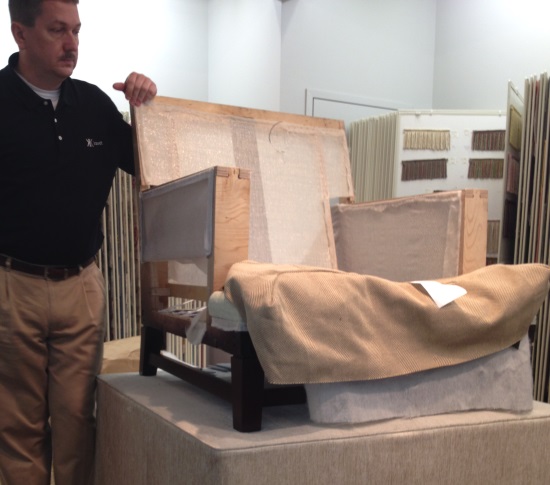
Beginning with a bare frame with pre-finished legs, upholsterer Steve Bolick gets started on the Pelham chair. See the dovetail joints at the arms? This gives the frame additional stability and prevents warping.
After the frame is built, the next major component is the seat support. The Kravet chair has a coiled spring base which provides just enough “give” under the cushion so that the cushion is not going to be compressed against a hard, unyielding surface (uncomfortable! and not good for the cushion either.) The springs are eight-way-hand-tied, which just means they are tied tightly to each other and to the frame in every direction, so that they move in unison and provide a nice level seat. Lesser quality chairs take shortcuts by either omitting the hand-tying, or omitting the springs altogether, which will negatively affect comfort and longevity of the chair.
Next, several layers of foam and batting are added as underpinnings before the upholstery fabric can be applied. A molded foam edge is put on the front rail of the chair (the edge under the cushion where the underside of your knee would hit). Foam and batting are wrapped and stapled around all of the wood edges of the frame for comfort and to provide a firm yet cushy base for the fabric. Cheaper chairs leave out some of these layers, which not only reduces comfort but exposes the fabric to more wear and tear.
Once the chair is fully wrapped and ready, the final upholstery fabric is carefully attached via the highest-tech staple gun I have ever seen (or heard, for that matter. It was so quiet!) Kravet takes extra care to line up fabric patterns on center, and so the pattern matches at the edges. Even though the herringbone pattern fabric used for this chair is subtle, it’s still applied exactly on center, and it matches where the top of the chair meets the back. Impressive! That is another detail you’ll not typically see on a lesser chair.
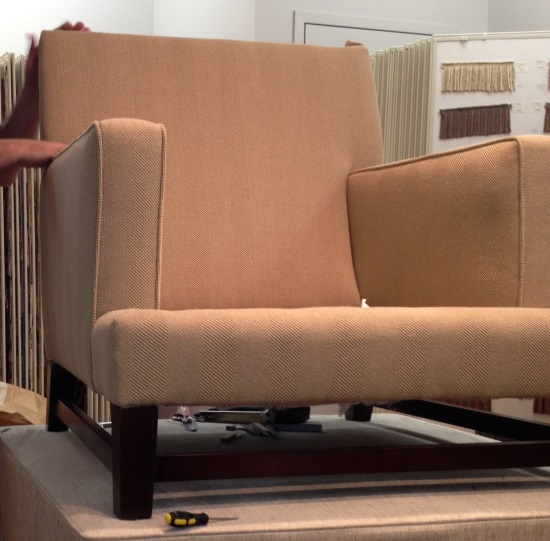
Almost done! Welting at the chair arm edges has been sewn and attached with perfect precision so that it runs straight along the edges.
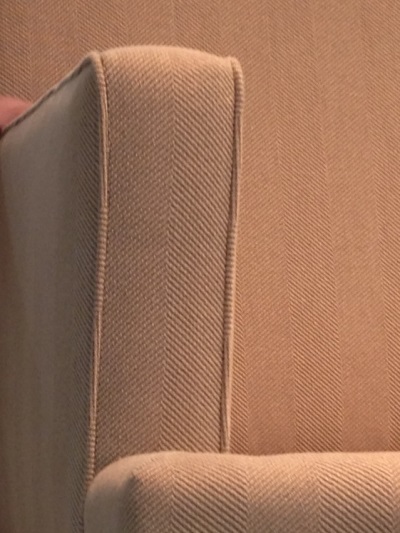
You have to look at this close up. See how the herringbone pattern is exactly centered on the arm? That’s impressive.
Last, the cushions are added to the back and seat, giving the chair is essential coziness and comfort. The Kravet cushions are constructed similarly to a mattress, with inner springs wrapped in foam and fiber. While a typical chair cushion would be made entirely of foam, the springs added to the Kravet cushions give them an extra long life. You will not see any “butt prints” left behind on these cushions!
Finally we arrived at the moment all were waiting for: the drawing. I had absolutely zero expectations because I am NOT a drawing winner. In fact I had never EVER won a drawing before. But I guess it was my lucky day because my business card was the one pulled from the bowl! It also happened to be my wedding anniversary yesterday, which made winning extra special.
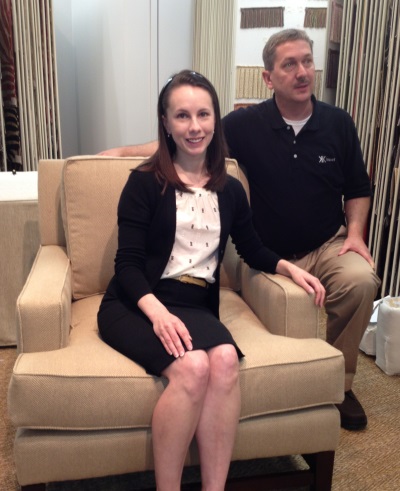
While I do not look especially comfortable in this moment, due to having my photo taken, I can assure you that this is one SUPER comfortable chair.
As soon as I can figure out a way to get my prize home, I can’t wait to settle into this baby with a good book. Want to see for yourself how a really nice chair feels? Come on over and test it out!
———
Tamara Leicester is a licensed interior designer and owner of Tamara Heather Interior Design, LLC. She designs casually elegant interiors with an artistic sensibility, often drawing upon the talent of local artists and craftspeople in her work. Dreaming about updating your space? Learn more at tamaraheatherinteriors.com.

